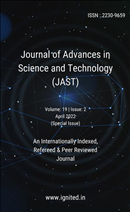Study Social Characteristics of Estimate Electrical Load
DOI:
https://doi.org/10.29070/2we5k929Keywords:
Social, Electrical Load, Microgrids, Electricity, PowerAbstract
Over 1.5 billion people in the world today are still without access to electricity with many of them living in rural and remote areas that are far away from the national main grid. First, an examination of the issues surrounding microgrids for rural electrification is carried out with a major focus on the sustainability challenges. Informed by this examination, the important factors to consider when evaluating sustainability are presented and an easy-to-use sustainability evaluation tool kit is proposed and tested against three microgrid projects. This approach utilizes “Mixed Integer Linear Programming (MILP)” to optimally size the PV microgrid and the “Density Based Spatial Clustering of Applications with Noise (DBSCAN)” algorithm to aggregate load and meteorological data. MATLAB software is used to execute the optimization algorithm. The critical elements that have to be considered when designing microgrids for rural communities are addressed with the aim of reducing the overall cost of electricity.
Downloads
References
Chambon, C. L., Karia, T., Sandwell, P., & Hallett, J. P. (2020). Techno-economic assessment of biomass gasification-based mini-grids for productive energy applications: The case of rural India. Renewable Energy, 154, 432-444.
Rehmani, A. M., & Akhter, P. (2019, October). Techno-economic analysis of hybrid renewable energy systems for rural area energization in Pakistan. In 2019 3rd international conference on energy conservation and efficiency (ICECE) (pp. 1-6). IEEE.
Banacloche, S., Herrera, I., & Lechón, Y. (2020). Towards energy transition in Tunisia: Sustainability assessment of a hybrid concentrated solar power and biomass plant. Science of The Total Environment, 744, 140729.
Sethi, V. P., & Dhiman, M. (2020). Design, space optimization and modelling of solar- cum-biomass hybrid greenhouse crop dryer using flue gas heat transfer pipe network. Solar Energy, 206, 120-135.
Khosravi, A., Santasalo-Aarnio, A., & Syri, S. (2021). Optimal technology for a hybrid biomass/solar system for electricity generation and desalination in Brazil. Energy, 234, 121309.
Kumar, A., & Verma, A. (2021). Optimal techno-economic sizing of a solar-biomass- battery hybrid system for off-setting dependency on diesel generators for microgrid facilities. Journal of Energy Storage, 36, 102251.
Allouhi, A., Rehman, S., & Krarti, M. (2021). Role of energy efficiency measures and hybrid PV/biomass power generation in designing 100% electric rural houses: A case study in Morocco. Energy and Buildings, 236, 110770.
Cao, Y., Dhahad, H. A., Togun, H., Anqi, A. E., Farouk, N., & Farhang, B. (2021). A novel hybrid biomass-solar driven triple combined power cycle integrated with hydrogen production: Multi-objective optimization based on power cost and CO2 emission. Energy Conversion and Management, 234, 113910.
Chen, H., Xue, K., Wu, Y., Xu, G., Jin, X., & Liu, W. (2021). Thermodynamic and economic analyses of a solar-aided biomass-fired combined heat and power system. Energy, 214, 119023.
Tilahun, F. B., Bhandari, R., & Mamo, M. (2021). Design optimization of a hybrid solar-biomass plant to sustainably supply energy to industry: Methodology and case study. Energy, 220, 119736.
Middelhoff, E., Furtado, L. A., Peterseim, J. H., Madden, B., Ximenes, F., & Florin, N. (2021). Hybrid concentrated solar biomass (HCSB) plant for electricity generation in Australia: Design and evaluation of techno-economic and environmental performance. Energy Conversion and Management, 240, 114244.
Mendecka, B., Chiappini, D., Tribioli, L., & Cozzolino, R. (2021). A biogas-solar based hybrid off-grid power plant with multiple storages for United States commercial buildings. Renewable Energy, 179, 705-722.
Ndukwu, M. C., Horsfall, I. T., Ubouh, E. A., Orji, F. N., Ekop, I. E., & Ezejiofor, N. R. (2021). Review of solar-biomass pyrolysis systems: Focus on the configuration of thermal-solar systems and reactor orientation. Journal of King Saud University- Engineering Sciences, 33(6), 413-423.
Emovon, I., & Oghenenyerovwho, O. S. (2020). Application of MCDM method in material selection for optimal design: A review. Results in Materials, 7, 100115.
Habib, S. M., Suliman, A. E. R. E., Al Nahry, A. H., & Abd El Rahman, E. N. (2020). Spatial modeling for the optimum site selection of solar photovoltaics power plant in the northwest coast of Egypt. Remote Sensing Applications: Society and Environment, 18, 100313.






